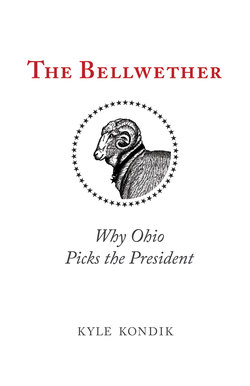Читать книгу The Bellwether - Kyle Kondik - Страница 13
На сайте Литреса книга снята с продажи.
ОглавлениеTHREE
Typical in All Things
“Perhaps, as the social scientists say, we are only a national average, a convenient yard stick, typical in all things, singular in nothing,” Harlan Hatcher writes in The Buckeye Country. Hatcher, an Ohio State University professor and fifth-generation Ohioan, did not agree with the assessment, though: “We Ohioans know that there is an illusive something more . . . the subtle X that colors our politics and religion; that gives tone to our big cities, and our country acres; that emanates from the college campuses and university halls; that broods over the hills of the Muskingum valley and over the lake shore and the plains; and we call it simply Ohio.”1
From a political standpoint, figuring out that “subtle X” is crucial to understanding Ohio’s presidential voting history. What is it about Ohio that places it so close to the national average in presidential elections? Is it something unique about the state—or is it something decidedly non-unique?
OHIO’S REGIONS
Before exploring why the state mirrors the nation, it’s first important to take a quick look at the state’s politically and culturally diverse regions. The Ohio Politics Almanac, created by former Columbus Dispatch associate publisher Mike Curtin (who also has served in the state legislature as a Democrat), divides the state into six.
These regions are based in part on Ohio’s media markets, which is very important in political campaigns because of the massive amounts of money each campaign and its allies spend on television advertising. The rise of targeted advertising through cell phones and Internet browsing may eventually make such media market distinctions less important, but as of the mid-2010s television advertising on broadcast and cable was still the primary way that campaigns reached voters.
Let’s take a closer look at these six regions and how they voted from 2000 to 2012. While in 21st-century elections the state—like the nation—features a strong urban versus rural dynamic, with Republican candidates winning most of the counties but Democrats running strong in the state’s most populated areas, there is a regional divide in the state as well, with the northeastern part of the state being the most Democratic and Republican strength lying in the western and southern portions of the state.
MAP 3.1. Ohio’s six regions. Source: OhioElectionResults.com
Northeast: Anchored by Cleveland, this Rust Belt area is the state’s electoral powerhouse. It casts the most votes, both Democratic and Republican, in state elections, and it’s also the state’s most Democratic region. Its two-party voting (57 percent Democratic) in 2000–2012 most resembled New Jersey, a reliably Democratic mid-Atlantic state. That’s about six points more than the 51 percent going to the Democratic candidate in national two-party voting during the same period.
Northwest: The northwest features the city of Toledo, which is Democratic, as well as a few swing counties and then a number of bedrock GOP areas. Its voting (51 percent Democratic) most resembles Nevada’s in recent elections, making it a swing region overall.
Central: Franklin County (Columbus) is the only county in this region that’s very Democratic, but the state’s most populous county’s increasing lean toward the Party of Jackson makes the whole region competitive. It, too, is a swing region, but one that has been slightly less Democratic (49 percent) than the northwest over the last four elections, with voting that is most similar to Virginia’s.
West: This small region based around Dayton is mostly conservative. At 57 percent Republican, its voting mirrors Louisiana’s.
Southwest: Greater Cincinnati has long been the heart of Ohio Republicanism, even though Hamilton County, where Cincinnati is located, became a swing county in the 21st century. At an average of 58 percent Republican the past four elections, its voting is closest to Montana, a reliably Republican western state.
